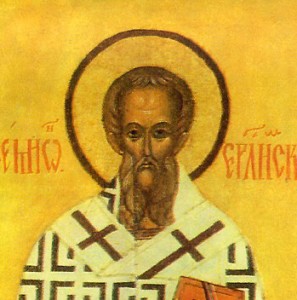In our time, old age is not considered a good thing. We do everything we can to minimize its effects (wearing youthful clothes, dying our hair, even having plastic surgery) and, when the effects of old age have become a burden, some would even advocate euthanasia or assisted suicide.
But those of us who are Orthodox sing “God grant you many years” and we know that throughout history and in most of the world, a long life has been considered a blessing from God. We sing in the Psalms, “So teach us to number our days that we may apply our hearts unto wisdom” [Ps. 90:12] and we understand that the years God gives us are for learning his ways and striving to become holy. St. Simon is the perfect example of one who was given many years and who used those years to help spread the Gospel to the world.
We learn from Holy Scripture that Simon (sometimes given as Simeon) was the son of Clopas, brother to St. Joseph, the Betrothed of the Blessed Virgin Mary; therefore, he was a first cousin of Our Lord Jesus Christ, believed to have been eight or nine years older than Christ. He had first-hand knowledge of the Incarnate Lord; he heard in family settings the words of Christ; he witnessed closely the miracles. And when Jesus had chosen his twelve Apostles – his “inner circle” of followers – and appointed seventy others to help spread the Good News, Simeon was among that number.
After the Resurrection, when the Apostles began the task of organizing the Church, St. James, the “brother” (step-brother) of the Lord was made the first Bishop of Jerusalem. According to tradition, he was executed by the Jews on orders from the Sanhedrin (the governing body of the Temple) for preaching about Jesus. He was thrown from the walls of the Temple and then beaten to death around the year 62. A successor was needed immediately for this important leadership position and Simeon was chosen by the remaining Apostles as the most worthy.
According to some historians, Bishop Simon led his Christian flock out of the city of Jerusalem to the city of Pella as the Jewish revolt against Roman rule and the siege of Jerusalem under Emperor Vespasian began in the year 66; the Temple built by Herod was destroyed in 70. The Christians returned to a Jerusalem in ruins but rebuilt their lives, and the Church grew and flourished under the leadership of the Bishop.
When Trajan became the Roman Emperor in 98, he began a double persecution: first, of the Jews who were in the royal line of succession – of the House of David – and secondly, of those who were Christian. Bishop Simon qualified on both counts. He was already a very old man, loved and revered by his people, but the Governor of Palestine, Atticus, was extremely zealous in following orders, so St. Simeon was arrested and crucified just as his Savior had been, around the year 107.
God had given Simon many years – over 100 – and he had used those years well. He had been a faithful follower of Christ, a loving pastor of his people, an ardent missionary, and now he had to be a courageous martyr. Holy Simon, pray for us that we may follow your example and use the years we are given for the glory of God.
Sources: A Cloud of Witnesses by Bishop Demetri; Prologue From Ochrid by St. Nikolai of Ochrid; Orthodox Saints, Volume Two by George Poulos; The Orthodox Study Bible; Wikipedia article.
